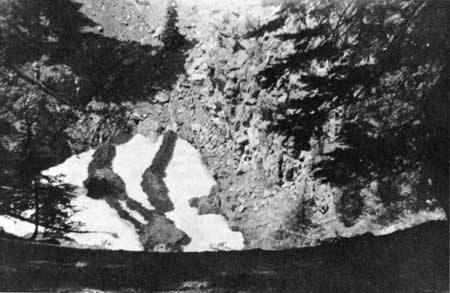Snow Crater – Nature’s Calendar
Snow Crater is a unique and interesting feature of Crater Lake National Park. It is located in the summit of Scoria Cone in a remote section of the Park near the South Boundary. It may be reached by traveling about one and a half miles on the Red Blanket Motorway, and then about one and a half miles in a southeasterly direction. Regardless of the heat of the summer season, the snow that has fallen in this crater from the previous winter never entirely melts; thus over a period of years a sizable mass of snow has accumulated in the depression at the top of the cone. It is particularly interesting to note that a season’s accumulation of snow in the crater constitutes a distinct layer, clearly demarked from the younger layers above and the older layers below.
The layers or “varves” of snow remind one of the varves that are often deposited by lake waters and from which it is possible to learn much regarding the time and conditions during which the lake existed. Varves deposited by a lake consist of alternating layers of dark and light sediments. During the summer, the life in a pond or lake is on the increase because of good growing conditions, and likewise, is on the decline in late fall and winter. As winter approaches and organic matter dies, it settles and turns dark, thus creating a dark layer of sediment. During the colder months, the sediments laid down are of an inorganic nature and much lighter than the previous ones. Thus one layer of both dark and light constitutes the sediments laid down during a one- year period and gives rise to a single verve from which a geologist may read certain facts regarding the conditions prevailing in the lake during the deposition.
The accumulation of snow and debris in Snow Crater here in the Park is in many respects analogous to the formation of the varves of a lake. Each winter brings about an accumulation of snow. and then during the summer, a layer of rocks, dirt, and debris from the trees forms on top of the snow. In this manner there is developed a “snow verve,” representing one year of deposition.

Looking into Snow Crater from the summit of Scoria Cone about fifty feet above the surface of the snow. The streaks are mud that has washed over the snow from heavy rains.
As far as I have been able to determine, Snow Crater has been visited only about four times since 1948. During 1948, Rangers William Kinsley, Richard Marquis, and a third person visited the Crater at least twice. On the second trip, an exploration was made in a crevice between the snow and the rock wall and, according to the report of Ranger Marquis, about 75 snow varves were counted, representing as many years of snow accumulation. In 1949 Ranger Kinsley and I visited Snow Crater but we were unable to make any further studies because of the unusually heavy snowfall of the preceding winter. During the summer of 1952 I was able to make a second trip to this remarkable crater. The accompanying photograph was taken at that time. The near record snowfall of the 1951-52 winter had hidden all of the possible exposures at which the snow varves might have been counted. It seems very possible that further exploration will be fruitless until perhaps mid-September, barring an early winter.
Snow Crater is one of the many out-of-the-way features of Crater Lake National Park rarely visited by any of the thousands of individuals who come to the Park each summer. I hope that this Nature Notes article will serve to call this interesting accumulation of snow to the attention of hikers and those who are interested in geology. I am sure that there are many Park visitors who will find a trip to Snow Crater a fascinating experience.

